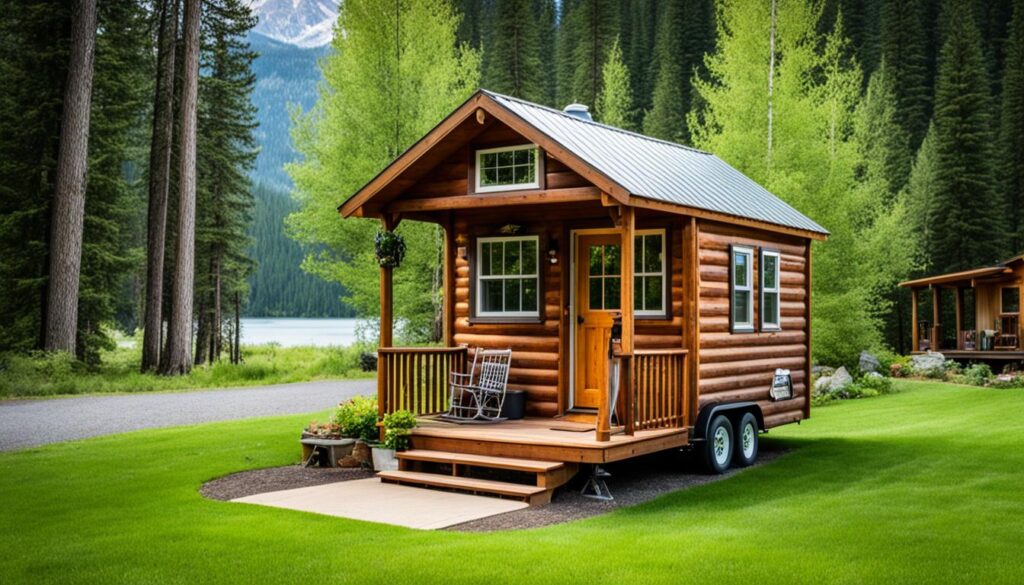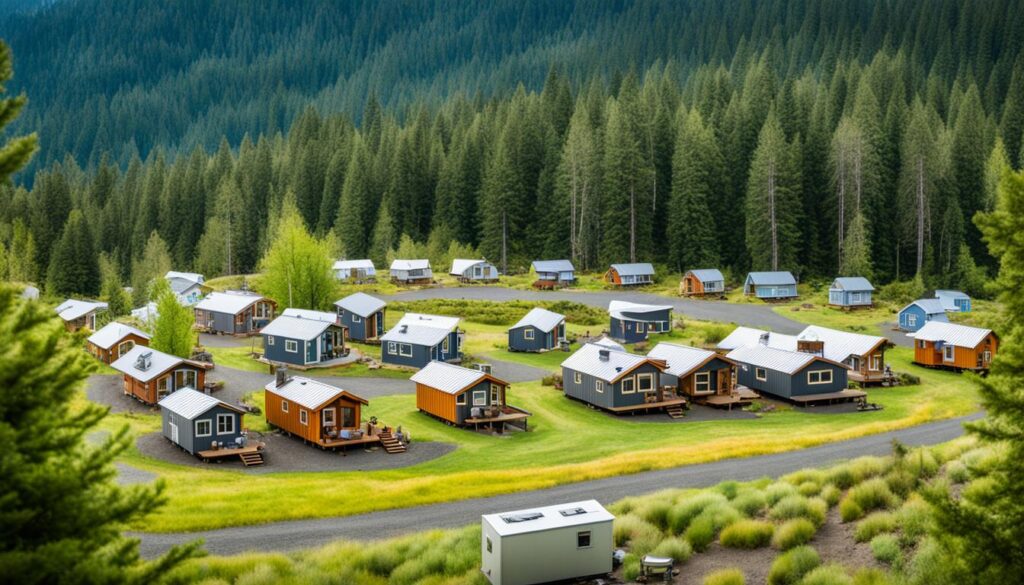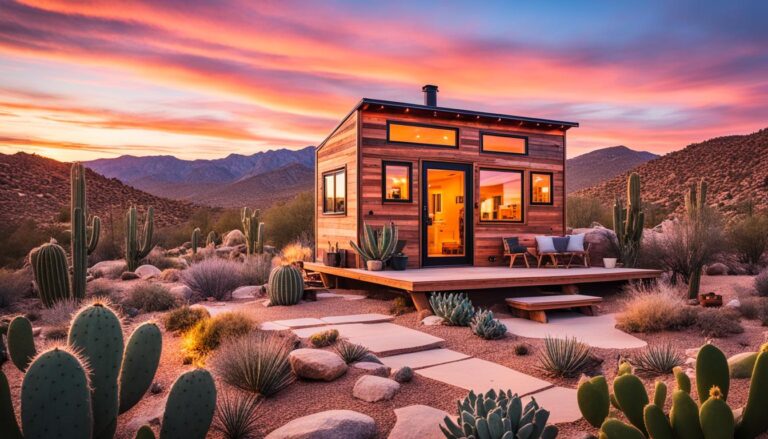Tiny House Placements in Oregon – Your Options
Did you know that Oregon is one of the most tiny house-friendly states in the United States? With its picturesque landscapes and forward-thinking attitude, Oregon has become a haven for tiny house enthusiasts and homeowners. Whether you are looking to build a permanent residence, explore temporary options, or embrace a transitional lifestyle, Oregon offers a range of suitable locations for your tiny home.
When it comes to placing a tiny house in Oregon, there are important factors to consider, such as zoning laws, building codes, and local regulations. This guide will provide you with valuable information about where you can put a tiny house in Oregon, the different types of placements available, and the specific requirements you need to meet.
Key Takeaways:
- Oregon offers various options for placing a tiny house, including permanent, temporary, and transitional placements.
- Zoning laws, building codes, and local regulations must be navigated to find the perfect spot for your tiny home in Oregon.
- Popular counties in Oregon, such as Clackamas, Lincoln, Multnomah, and Marion, are known for their acceptance of tiny houses and have specific regulations to accommodate them.
- Research and obtain the necessary permits and work with certified builders and contractors to ensure compliance with Oregon’s building codes and regulations.
- Consider purchasing private property, utilizing tiny house communities, or exploring the option of building an accessory dwelling unit (ADU) on your property.
Where Can I Place a Permanent Tiny Home in Oregon?
When it comes to placing a permanent tiny home in Oregon, there are two main options to consider. The first option is site-built construction, where you build your tiny home following the Small Home Specialty Code (SHSC). This code ensures that your tiny home meets the same requirements as other permanent dwellings in Oregon. By building your tiny home on-site, you have more control over the design and customization.
The second option is purchasing a manufactured tiny home that meets the Housing and Urban Development (HUD) construction and safety standards. HUD-approved manufactured homes offer a convenient and efficient way to own a tiny home in Oregon. It’s important to ensure that the manufactured unit is built in a federally approved facility to meet all the necessary standards and regulations.
Whether you choose site-built construction or a manufactured tiny home, you must comply with local zoning laws and building codes. Zoning laws for tiny homes in Oregon determine where you can place your tiny home, such as residential or mixed-use areas. Building codes for tiny houses in Oregon are in place to ensure the safety and structural integrity of the home. It’s crucial to familiarize yourself with these codes and regulations to ensure a smooth and compliant construction process.
By adhering to zoning laws and building codes, you can confidently place your permanent tiny home in Oregon and enjoy the benefits of this unique housing option.
- Zoning laws for tiny homes in Oregon
- Building codes for tiny houses in Oregon
Can I Place a Temporary Tiny Home in Oregon?
Temporary tiny homes provide a flexible housing option for individuals seeking mobility and affordability. In Oregon, these homes can be placed in certain cases, but it’s crucial to understand the regulations and requirements involved.
Typically, temporary tiny homes are attached to a frame or chassis and considered vehicles rather than traditional dwellings. As vehicles, they must meet Federal Motor Vehicle Safety Standards to ensure safety while on the road.
Moreover, these homes can only be placed temporarily and must bear certification from the RV Industry Association (RVIA). This certification verifies that the home meets specific standards and requirements for recreational vehicles.
Oregon Administrative Rules outline provisions for temporary tiny homes and RVs in designated areas. However, it’s important to note that these provisions have an expiration date, and local zoning regulations determine the number of structures allowed in specific areas.
To gain a comprehensive understanding of the regulations and guidelines surrounding temporary tiny homes in Oregon, it’s advisable to consult local authorities and familiarize yourself with Oregon Administrative Rules and zoning regulations.
Temporary Tiny Home Regulations in Oregon
- Temporary tiny homes are attached to a frame or chassis and considered vehicles.
- These homes must meet Federal Motor Vehicle Safety Standards.
- Certification from the RV Industry Association (RVIA) is required.
- Oregon Administrative Rules allow temporary tiny homes and RVs in specified areas.
- Zoning regulations determine the number of structures allowed.
By adhering to the regulations and ensuring proper certification, individuals can enjoy the freedom and flexibility of placing a temporary tiny home in Oregon.

Transitional Tiny Home Housing in Oregon
Within urban growth boundaries and certain unincorporated communities in Oregon, transitional housing units can be established to provide interim shelter. These units offer a unique and affordable solution for individuals seeking temporary housing options.
Transitional housing units in Oregon encompass a variety of structures, including yurts, cabins, and other types of accommodations. These units are designed to be portable, flexible, and suitable for different needs. Whether you’re a student looking for a temporary place to stay during the academic year or someone in transition between permanent homes, transitional housing provides a comfortable and functional living space.
In Oregon, each municipality has the authority to establish and regulate transitional housing units, following the Oregon Transitional Housing Standard. This ensures that these units meet the necessary safety and quality standards while providing a practical living environment for residents. It’s important to check with local governments to understand the specific regulations and guidelines regarding transitional housing in your area.
If you’re considering transitional tiny home living in Oregon, there are several advantages to keep in mind. Firstly, these units are cost-effective, offering affordable housing options for those on a tight budget. They also promote sustainability and minimalism, encouraging individuals to live with fewer possessions and prioritize experiences over material possessions.
Additionally, transitional tiny home communities in Oregon provide a supportive and like-minded environment. Living in a community of individuals who share similar values and interests can foster a sense of belonging and camaraderie. It offers an opportunity to connect with others who appreciate the tiny home lifestyle and provides a supportive network for individuals navigating transitional housing.
Overall, transitional housing units and tiny home communities in Oregon offer an alternative and innovative approach to temporary housing. They provide a practical solution for individuals seeking affordable, flexible, and sustainable living options. By embracing the benefits of transitional tiny homes, you can embark on a unique living experience that combines simplicity, affordability, and a sense of community.
Finding Land for Your Tiny House
When it comes to finding land for your tiny house in Oregon, you have several options to consider. Each option has its own set of advantages and considerations, so it’s important to research and understand the local regulations in order to make an informed decision.
Purchasing Private Property: One option is to purchase your own private property that is zoned for residential use and complies with relevant building codes. This allows you the freedom to design and build a permanent foundation for your tiny house. It’s important to check with local authorities and obtain the necessary permits before proceeding.
Parking in a Tiny House Community or RV Park: If you prefer a more communal living experience, you can park your tiny house on wheels in a designated tiny house community or RV park. These communities often provide amenities and a supportive community of like-minded individuals. Be sure to inquire about the specific regulations and any fees or restrictions that may apply.
Building an Accessory Dwelling Unit (ADU): Some municipalities in Oregon allow homeowners to build accessory dwelling units (ADUs) on their property. ADUs can include tiny houses and are a great way to add additional living space while maximizing land use. Check local regulations to determine if this option is available in your area.
Regardless of the option you choose, it’s crucial to thoroughly research and understand the local regulations, obtain the necessary permits, and work with professionals who are knowledgeable in tiny house construction and placement. This will ensure a smooth and successful process as you embark on your tiny house journey in beautiful Oregon.

Best Areas for Tiny Homes in Oregon
- Portland Metro Area: The Portland metro area, including Multnomah County, has shown a greater acceptance and support for tiny houses. Considered the tiny house hub of Oregon, this area offers a variety of resources and communities for tiny house enthusiasts.
- Central Oregon: The Central Oregon region, including Deschutes County, is known for its picturesque landscapes and outdoor recreational opportunities. This area attracts tiny house enthusiasts looking for a more remote and nature-focused lifestyle.
- Coastal Oregon: The Oregon coast, particularly counties such as Lincoln and Clatsop, offers stunning views and a relaxed coastal lifestyle. This region has embraced the tiny house movement, with communities and parks catering to tiny house enthusiasts.
- Rogue Valley: The Rogue Valley region, encompassing counties such as Jackson and Josephine, is known for its mild climate and abundant natural beauty. It’s a popular destination for those seeking a quieter, rural lifestyle in their tiny homes.
These are just a few examples of the best areas for tiny homes in Oregon. Each region offers its own unique charm and benefits, so it’s important to consider your personal preferences and lifestyle when choosing the location for your tiny house.
Understanding Oregon’s Building Codes for Tiny Homes
Oregon has specific building codes and standards in place for tiny homes, which are essential to understand when planning to build or purchase one. These codes ensure the safety and compliance of tiny homes within the state.
The Oregon Residential Specialty Code (ORSC) is applicable to tiny homes under 600 square feet. It allows for certain accommodations, such as sleeping lofts with ladder access and fire sprinkler systems. These features provide functionality and safety in compact living spaces while adhering to regulatory requirements.
Furthermore, Oregon has established the Oregon Small Home Specialty Code (OSHSC) specifically for single-family residences up to 400 square feet in size. This code recognizes the unique characteristics of tiny homes and grants them the flexibility to meet the needs of homeowners without compromising on quality or safety.
It is crucial to familiarize yourself with these building codes to ensure that your tiny home meets the necessary standards. Working with certified builders and contractors who are well-versed in these codes can offer peace of mind and ensure that your tiny home meets all legal requirements.
If you need more information on Oregon’s building codes for tiny homes or want to delve into specific guidelines, visit the Great Lakes Tiny Homes website. They provide comprehensive insights into the legal requirements and regulations pertaining to tiny homes in Oregon.
Tiny House-Friendly Counties in Oregon
Certain counties in Oregon have shown greater acceptance and accommodation for tiny houses. If you’re looking to place your tiny house in a county that welcomes this housing option, consider Clackamas County, Lincoln County, Multnomah County, and Marion County.
Clackamas County
Clackamas County, which includes the city of Portland, has regulations that allow for tiny houses and tiny houses on wheels (THOWs) as accessory dwelling units in residential zones. This means you can legally place your tiny house in this county, giving you the freedom to enjoy the benefits of living in a tiny home while still being close to urban amenities and the vibrant Portland community.
Lincoln County
Lincoln County is home to Tiny Tranquility Park, a community that welcomes tiny houses. This county offers a serene location to park your tiny home and enjoy the tranquility of Oregon’s beautiful natural landscapes. Whether you’re looking for a vacation spot or a permanent residence, Lincoln County provides an accepting environment for tiny house living.
Multnomah County
In Multnomah County, where Portland is located, you’ll find a progressive attitude towards housing options, including tiny houses. The county permits various types of additional buildings, making it an ideal place to explore tiny house living. With its vibrant culture, endless outdoor recreational opportunities, and a welcoming attitude towards alternative housing, Multnomah County is an excellent choice for placing your tiny house.
Marion County
Marion County allows tiny houses in certain areas, subject to local zoning and building regulations. This county offers a mix of urban and rural environments, making it an attractive option for individuals seeking a tiny house lifestyle. Researching and understanding the specific regulations in Marion County is essential to ensure a smooth process when placing your tiny house.
When considering where to place your tiny house in Oregon, these counties provide favorable conditions and regulations that align with the tiny house movement. Whether you prefer the bustling city life or the tranquility of nature, you can find a county that suits your lifestyle and offers a supportive community for your tiny house adventure.
Tiny House Communities in Oregon
Oregon is home to several tiny house communities where individuals can live and share the tiny house lifestyle. One such community is Tiny Tranquility Park in Waldport, which offers amenities such as laundry facilities, outdoor grilling areas, and a dog park. Another option is a tiny home village near Mt. Hood, providing a unique view of the mountain.
Some communities offer proximity to urban areas like Portland, while others provide a more secluded, nature-focused experience. Living in a tiny house community allows residents to connect with like-minded individuals and enjoy a sense of community. These communities often organize events and activities, fostering a supportive and engaging environment.
When considering a tiny house community, it’s important to vet potential options and consider factors such as location, amenities, and regulations. Each community may have specific guidelines regarding the types of tiny homes allowed and the length of stay. Researching and visiting different communities can help in finding the one that best suits your lifestyle and preferences.
If you’re interested in learning more about the regulations and guidelines for tiny house communities in Oregon, you can refer to the occupied RVs and tiny houses on wheels page provided by the City of Portland’s Bureau of Development Services.
Conclusion
In summary, Oregon offers a range of choices for placing your tiny house, whether you’re looking for a permanent residence, a temporary option, or transitional housing. It’s important to navigate the state’s zoning laws and building codes to ensure compliance with regulations. Researching and obtaining permits, as well as working with certified builders and contractors, is essential to a successful tiny house placement in Oregon.
Certain counties in Oregon, including Clackamas, Lincoln, Multnomah, and Marion, have embraced the tiny house movement and provide a supportive environment for tiny house owners. These counties have established regulations and guidelines that allow for the placement of tiny houses in designated areas, offering individuals the opportunity to live their dream of a minimalist lifestyle.
If you’re seeking a sense of community and a chance to connect with like-minded individuals, Oregon also boasts several tiny house communities. These communities provide a unique living experience, with amenities and a supportive network of fellow tiny home enthusiasts. Consider options such as Tiny Tranquility Park in Waldport or the tiny home village near Mt. Hood.
With the right knowledge and careful consideration of the local regulations, you can find the perfect spot to place your tiny house in scenic Oregon. So, whether you’re looking for a permanent residence, a temporary getaway, or a community-oriented lifestyle, explore the options available and start your tiny house journey in Oregon.
*To learn more about the counties in Oregon that allow tiny houses, visit Great Lakes Tiny Home.
FAQ
Where can I put a tiny house in Oregon?
Oregon offers various options for placing a tiny house, including private property, designated tiny house communities or RV parks, and properties that allow accessory dwelling units (ADUs).
What are the zoning laws and building codes for tiny homes in Oregon?
The zoning laws and building codes for tiny homes in Oregon vary depending on the type of tiny home. Permanent tiny homes must comply with local zoning laws and follow either the Small Home Specialty Code (SHSC) or Housing and Urban Development (HUD) construction standards. Temporary tiny homes must meet Federal Motor Vehicle Safety Standards and bear certification from the RV Industry Association (RVIA).
Can I place a temporary tiny home in Oregon?
Yes, temporary tiny homes, also known as tiny homes on wheels (THOWs), may be allowed in Oregon under certain conditions. However, they are considered vehicles and can only be placed temporarily.
What are the transitional housing options for tiny homes in Oregon?
Transitional housing units, including yurts and cabins, can be established within urban growth boundaries and certain unincorporated communities in Oregon. Each municipality has the authority to establish and regulate these units.
Where can I find land for my tiny house in Oregon?
You can find land for your tiny house in Oregon by purchasing private property that is zoned for residential use, parking in a designated tiny house community or RV park, or building an accessory dwelling unit (ADU) on your existing property.
What are the building codes for tiny homes in Oregon?
Oregon has the Oregon Residential Specialty Code (ORSC) for certain accommodations in tiny homes under 600 square feet. The Oregon Small Home Specialty Code (OSHSC) allows for the construction of single-family residences up to 400 square feet. Tiny homes built to HUD standards must also meet federal regulations.
Which counties in Oregon are friendly towards tiny houses?
Clackamas, Lincoln, Multnomah, and Marion counties in Oregon are known for their acceptance and accommodation of tiny houses. Each county has its own regulations and guidelines for placing tiny houses.
Are there tiny house communities in Oregon?
Yes, there are several tiny house communities in Oregon, including Tiny Tranquility Park in Waldport and a tiny home village near Mt. Hood. These communities offer various amenities and proximity to urban areas or natural surroundings.
What is the summary of tiny house placements in Oregon?
Oregon offers options for placing a tiny house, including permanent, temporary, and transitional options. It’s important to navigate zoning laws, building codes, and specific county regulations to find the perfect spot. There are also tiny house communities where individuals can live and experience the tiny house lifestyle.
Source Links
- https://www.greatlakestinyhome.com/what-counties-in-oregon-allow-tiny-houses/
- https://cdnsm5-hosted.civiclive.com/UserFiles/Servers/Server_3585797/File/Government/County Departments/Public Works/Land Management Division/Building Safety/Tiny Homes in Lane County.pdf
- https://www.tinyhousebasics.com/tinyhousetrailers/oregon/







